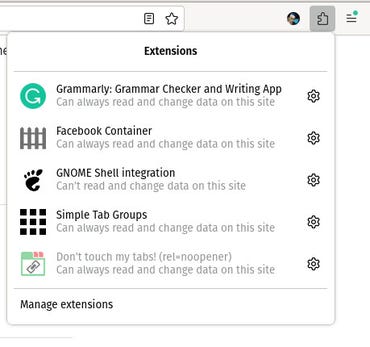Sometimes developers add features to an app, not necessarily to improve its performance, but rather to declutter it. By doing so, they improve the user experience and make the tool more pleasant to use.
One thing that has always bothered me in some browsers is how extensions are accessed and displayed in the toolbar. If too many extensions are added to the interface, it can become very cluttered.
And if there are too few extensions in the toolbar, they may be difficult to access. I’ve experienced both situations and neither is ideal for an efficient workflow or a clean interface.
That’s why, when Mozilla announced the Unified Extensions Button for Firefox 109, I was, by the looks of it, all for it. Because it’s a feature that every browser should consider adding.
Free and open source, Mozilla Firefox is the most popular cross-platform web browser. Light, fast and customizable with the many extensions available, it is available on computers and on smartphones and tablets.
- Downloads: 73
- Release date : 01/17/2023
- Author : Mozilla Foundation
- Licence : Free software
- Categories:
Internet - Operating system : Android – Linux – Windows 32 bit – XP/Vista/7/8/10/11 – Windows 64 bit – XP/Vista/7/8/10/11 – Windows Portable – XP/Vista/7/8/10/11 – iOS iPhone / iPad – macOS
What is the Unified Extensions button?
The Unified Extensions button replaces Firefox’s row of extensions with a button that offers a drop-down list. So you can access all the extensions you need without cluttering up the UI.

The Unified Extensions button declutters the Firefox user interface. Picture: Jack Wallen.
Instead of having all your extensions pinned to your toolbar, you have a single button (shaped like a puzzle piece), which you click to reveal your extensions.
One thing to keep in mind is that unlike a number of other browsers, where you have to worry about pinning tabs to the toolbar to access them, Firefox automatically pins an extension to the toolbar. ‘tools.
The more extensions you add, the more cluttered the interface. With the Unified Extensions button, you install an extension and it automatically appears in the drop-down list. It’s automatically clean and easy to use.
Manifest Version 3 (MV3)
The new Unified Extensions button was made possible by another new feature in the browser, namely Manifest Version 3 (MV3). MV3 allows users to permanently control which add-ons can access which web pages. According to Mozilla, “Users are free to grant permanent access to a website or make a choice each time they visit. To allow this, MV3 treats the host permissions (listed in the extension manifest) as an opt-in”.
MV3 was developed by Google to restrict the capabilities of web extensions, especially those designed to monitor, modify and calculate the exchange of information between a web browser and a website. In 2019, it was reported that developers were concerned that extension blockers were no longer working.
Some speculated it was an attempt by Google to circumvent ad blockers, given the company’s reliance on ads. And several developers of ad blocker extensions have proclaimed that deprecating a specific API would mean serious problems for ad blockers, antivirus products, parental control enforcement and privacy enhancement extensions. .
None of these fears actually came to fruition, and even though MV3 was implemented, ad blockers and other software and extensions still work flawlessly.
Other features
Firefox 109 now includes a built-in dictionary for Spanish from Spain (es-ES) as well as Spanish from Argentina (es-AR), which can be used in conjunction with Firefox’s spell checker.
There are also other improvements, including:
- better accessibility for those who use the screen reader;
- an improved Firefox view that allows you to close and remove links from the list of recently closed links;
- enables the scrollend event;
- permanent partitioning of storage into third-party contexts isolated from storage access for better compatibility;
- Arbitrary Code Guard exploit protection has been enabled for media playback to improve security for Windows users;
- the native HTML date picker for date and time entries can only be used with the keyboard;
- many security fixes
- the removal of Colorways;
- on macOS, press CTRL Where cmd and the trackpad or mouse wheel scrolls the page instead of zooming.
How to get Firefox 109
To get Firefox 109, you need to download it for your operating system from the official Firefox download page. If you are a Linux user, you can either use Firefox Nightly, run Firefox from source, or wait for the new version to be available in your distro’s standard repository.
I’m using Firefox Nightly, which is currently at version 110 and allows me to take a look at the latest features that may or may not be coming to the stable release soon. For macOS and Windows users, the update should download automatically.
You can view the window In regards to of Firefox to find out which version you are using. Eventually, however, both of these platforms will automatically upgrade Firefox to the latest version.
Source: ZDNet.com
